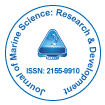Influences of Salinity on Embryonic and Larval Development of Striped Catfish Salinity Intrusion in Coastal Areas
Received: 03-Oct-2021 / Accepted Date: 18-Oct-2021 / Published Date: 23-Oct-2021 DOI: 10.4172/2155-9910.1000339
Introduction
Salinity intrusion in freshwater ecosystems of low-lying coastal areas poses a major threat to aquaculture and agricultural production. An experiment was conducted to observe the effects of salinity on early life development of the freshwater aquaculture species pabda, Ompok pabda. Fish embryos (n = 200) and fry (n = 100) were exposed to five different salinity concentrations viz., 0 (control), 2.5, 5.0, 7.5 and 10.0 ppt with three replications. The LC50 values were calculated by probit analysis [1]. The 24 h LC50 values recorded for embryos was 15.07 ppt and hatching success decreased significantly as salinity concentration increased. The 48 h LC50 values recorded for larvae was 5.07 ppt and larval developmental rate was reduced in response to an increase in salinity concentration. Mostly larval deformities were found from 5.0 to 10.0 ppt salinity. The 72 h LC50 values of fry was denoted as 2.42 ppt and fry mortality was augmented significantly with exposure time and salinity concentration. Fry mostly survived at 0 (92.67%) and 2.5 ppt (65.67%) salinities after 24 h exposure, but none survived at 5.0 and 7.5 ppt salinities after 48 h. 100% fry mortalities occurred at 10 ppt salinity after 24 h exposure. Thus, the present findings provide useful information on salinity effects on early life development of Ompok pabda and sensitivity for embryonic development [2]. It is expected that current findings will be helpful to raise awareness of the sensitivity of salinity for freshwater aquaculture species.
As a result of salinity intrusion and seasonal fluctuation of water salinity in coastal freshwater regions, many aquatic organisms including wild stock of commercially important fish species may be subjected to salinity stress. Eventually, some species may become extinct and or migrate from these areas due to loss of coping capacity with such extreme environments. It was evident that 12, 19 and 24% inland freshwater and brackish water fishes become extinct, endangered and threatened, respectively due to salinity intrusion in the riverine system across the coastal zone. However, the relationship between fish growth and water salinity is not clearly understood, as available information has shown differential response from species to species. For instance, growth rate of common carp, Cyprinus carpio decreased with an increase in water salinity while a change in salinity from 0 to 36 PSU did not affect the growth of tilapia [3].
A stock solution of saline water (30 ppt) was prepared by mixing brine with dechlorinated tap water. Natural brine with a salinity of 130 ppt was obtained from a government fish hatchery under the Department of Fisheries, Ministry of Fisheries and Livestock. Prior to the preparation of desired concentrations of saltwater, both brine and dechlorinated tap water were subjected to filtration by using 65 μm filter papers to remove debris and other unwanted suspended solids. Test water of different salinity 2.5, 5.0, 7.5 and 10.0 ppt were prepared by the addition of required amounts of dechlorinated tap water to the stock solution. This range of salinity was selected using expert judgement, in order to understand the effects of environmental water salinity due to its intrusion on different ontogenetic stages of the freshwater fish species [4]. The fish fries were obtained from the same pool of gametes, were used for the mortality test and exposed to salinity for 72 h. Water physico-chemical parameters were assessed separately for each treatment to establish whether they were maintained at recommended levels for the biology of the butter catfish.
References
- Matthias M, Anders L, Katja F, Alexander R, Ben M, et al. (2016) Future sea level rise constrained by observations and long-term commitment. Proceedings of the National Academy of Sci 113: 2597-2602.
- Akyildiz IF, Pompili D, Melodia T (2005) Underwater acoustic sensor networks: research challenges. Ad Hoc Netw 3: 257-279.
- Alexander R, Gikuma-Njuru P, Imberger J (2012) Identifying spatial structure in phytoplankton communities using multi-wavelength fluorescence spectral data and principal component analysis. Limnol Oceanogr Methods 10: 402-415.
- Al-Halafi A, Shihada B (2018) UHD video transmission over bidirectional underwater wireless optical communication. IEEE Photon J 10: 1-14.
Citation: Lowensohn R (2021) Influences of Salinity on Embryonic and Larval Development of Striped Catfish Salinity Intrusion in Coastal Areas. J Marine Sci Res Dev 11: 339. DOI: 10.4172/2155-9910.1000339
Copyright: © 2021 Lowensohn R. This is an open-access article distributed under the terms of the Creative Commons Attribution License, which permits unrestricted use, distribution, and reproduction in any medium, provided the original author and source are credited.
Share This Article
Recommended Journals
Open Access Journals
Article Tools
Article Usage
- Total views: 1746
- [From(publication date): 0-2021 - Mar 31, 2025]
- Breakdown by view type
- HTML page views: 1191
- PDF downloads: 555
